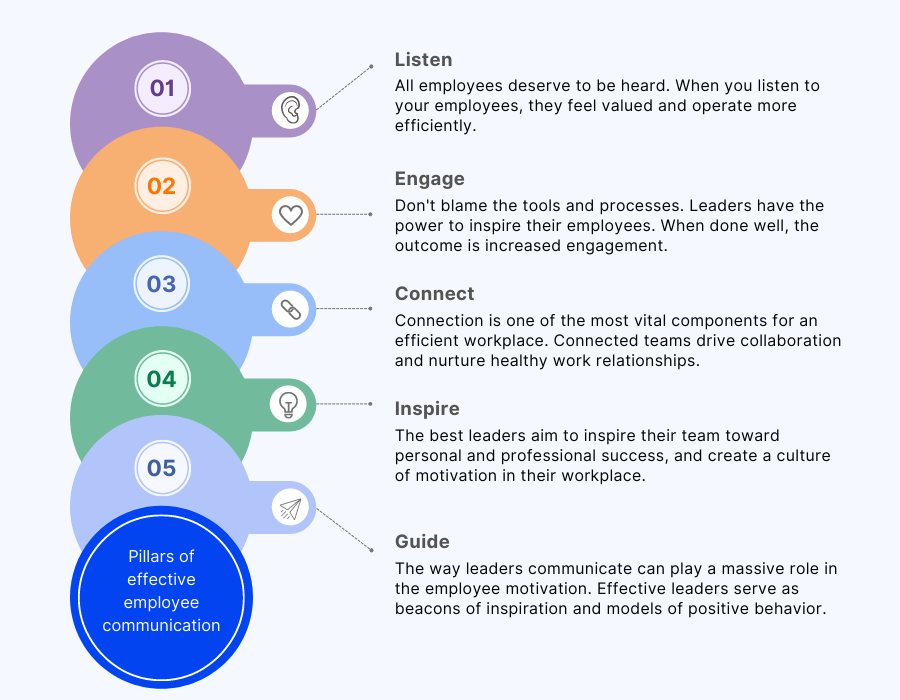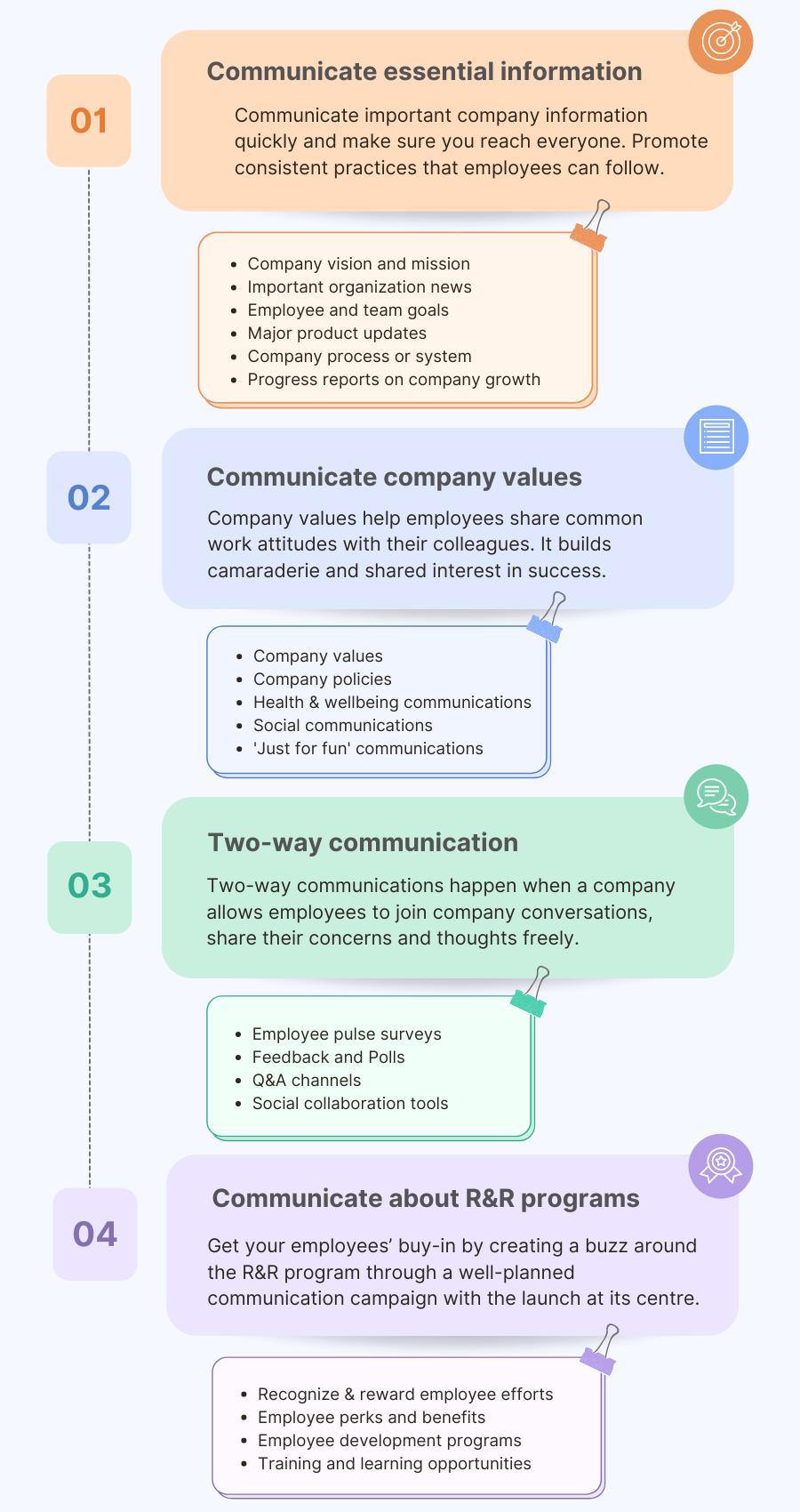¿Cuáles son los pilares de una comunicación eficaz en el trabajo?
Descubra los pilares de la comunicación que impulsan el éxito en el lugar de trabajo. Desde la claridad y la escucha activa hasta la retroalimentación y la transparencia, aprenda cómo las herramientas digitales y el diálogo abierto crean un equipo conectado, comprometido y de alto rendimiento.
En esta página
Paul J. Meyer dijo una vez sabiamente: "La comunicación -la conexión humana- es la clave del éxito personal y profesional " .
Conocido como el fundador de la "industria de la superación personal", las citas y contribuciones de Paul J. Meyer han resistido la prueba del tiempo y han sido aprobadas con éxito.
↠ Según McKinsey, una empresa con equipos bien conectados registra un aumento de la productividad de entre el 20% y el 25%.
↠ Según CMSWire, el 97% de los empleados afirma que la comunicación influye en la eficacia de sus tareas diarias.
↠ Según HBR, los empleados que trabajan en empresas que siguen prácticas de comunicación eficaces y minimizan el efecto silo mediante sistemas de comunicación centralizados tienen 3,5 veces más probabilidades de rendir mejor que sus compañeros.
Sin la estrategia de comunicación, la solución y la sinergia adecuadas, es difícil alinear a las múltiples partes interesadas de la organización.
Esto plantea una pregunta crucial: ¿Cuáles son los factores clave de una comunicación eficaz con los empleados? Cuando empiece a reflexionar sobre esta pregunta del millón, como empresario (líder), "escuchar" debe tener siempre prioridad sobre hablar. Dicho esto, he aquí cinco pilares de la comunicación en el lugar de trabajo que toda empresa debe respetar.
5 pilares de la comunicación en el lugar de trabajo
En esencia, la comunicación eficaz en el lugar de trabajo consiste en comprender y empatizar con su público. Para que tu estrategia de comunicación, la solución y la sinergia estén alineadas entre sí, asegúrate de centrarte en estos pilares: escuchar, participar, conectar, inspirar y guiar.

1. Escuchar
La reunión de HSBC Exchange (llamada internamente "Shut Up & Listen") es un testimonio de que las marcas ejecutan un programa de comunicación con éxito.
A primera vista, puede parecer un programa para los empleados, pero en cambio se hizo para los miembros de la alta dirección.
El motivo del programa era que los dirigentes escucharan a los empleados. Así, el equipo de comunicación interna abrió una línea de comunicación directa entre los dirigentes y los empleados.
En un programa muy necesario para recuperar la confianza de los empleados, no se permitió a los miembros de la dirección interrumpir, corregir, desviar o contrarrestar a los empleados. A los miembros de la dirección sólo se les permitió escuchar, tomar notas y proporcionar una actualización a través de Internet después del programa.
En un ejercicio con menos de diez personas en cada equipo, cada empleado tuvo la oportunidad de plantear directamente sus preocupaciones y quejas sin temor a represalias o repercusiones.
Mediante el despliegue clásico de una "reunión a nivel de saltos", los empleados discutieron las compensaciones a las quejas en el comedor directamente con los altos dirigentes de HSBC.
Una respuesta sencilla es que todos los empleados merecen ser escuchados. Cuando escucha a sus empleados, que son, sin duda, su mayor activo, se sienten valorados. El sentimiento de pertenencia acompaña a la sensación de ser valorado, y los empleados actúan inmediatamente con mayor eficacia.
Puede captar las opiniones de los empleados organizando reuniones a nivel de saltos (mencionadas en el estudio de caso anterior), debates abiertos, charlas de liderazgo, preguntas y respuestas, sondeos y encuestas.
Como líder, conocer de primera mano y con perspectiva la vida personal y profesional de sus empleados es útil y fundamental para la empresa.
Más adelante, puede medir el cambio en el sentimiento a través de encuestas periódicas sobre el pulso, contando a los empleados que vuelven al ejercicio y haciendo un seguimiento de las publicaciones en Glassdoor y otros.
Podrá utilizar esta experiencia de escucha y los datos cuantitativos para mejorar y orientar futuros esfuerzos de comunicación.
2. Involucrar a
Barclays, la empresa de servicios bancarios y financieros, ha dado un excelente ejemplo de compromiso sólido con el cliente a través de la formación y la comunicación.
La empresa lanzó su aplicación bancaria para Android e iOS, pero se dio cuenta de que sus empleados no sabían utilizarla. Por lo tanto, no podían atender a los clientes con eficacia. Consciente de la importancia de la tecnología y de su aplicación nativa, Barclays redobló sus esfuerzos lanzando el programa Digital Eagles.
El programa se compromete a enseñar a los empleados de Barclay's a utilizar la aplicación, a sacar el máximo provecho de Internet y a prestar un servicio completo a los clientes.
Convirtiendo a los novatos en expertos, los empleados recibieron una formación sin precedentes a través de la iniciativa Digital Eagles, y los resultados mostraron un asombroso aumento de 18 Digital Eagles a 18.000.
La iniciativa Águilas Digitales, un ejemplo clásico de cómo los líderes resuelven un problema acuciante mediante el compromiso con los empleados, demuestra que la comunicación con los empleados es vital.
Si tomamos el caso de Barclays, por ejemplo, los dirigentes se mantuvieron firmes a la hora de idear y resolver el problema en cuestión. Es fundamental comprometerse con el problema en el primer paso sin reaccionar de forma exagerada ni tomar medidas drásticas.
Cuando las marcas prueben, enseñen y aprendan junto con los empleados sobre la marcha, no sólo resolverán el problema actual, sino que también prepararán a su empresa para el futuro.
Para que se le ocurran esas ideas o las despliegue de forma eficaz, puede involucrar a sus empleados, hacer un crowdsourcing de ideas y crear un sentimiento de unidad dentro de la organización, que es otra forma de involucrar a sus empleados.
Vale la pena recordar que no todo tiene que salir de la dirección central. Fomenta una cultura en la que el diálogo bidireccional entre todas las jerarquías sea la forma más fácil de resolver los problemas de todas las escalas.
3. Conectar
Conectar con los empleados puede parecer similar a comprometerse, pero espere a leer el lío creado por la desconexión entre los líderes de PayPal y sus empleados.
David Marcus, el antiguo presidente de PayPal, cometió el error de dar un ultimátum a sus empleados. Al enterarse de que muchos de sus empleados no usaban la aplicación de PayPal, David adoptó el enfoque del megáfono de pedir a sus empleados que usaran la aplicación o renunciasen.
"Si eres uno de los que se negó a instalar la aplicación de PayPal o si no recuerdas tu contraseña, hazte un favor, ve a buscar algo que conecte con tu corazón y tu mente en otro lugar" - David Marcus.
Después de que el memorándum anterior se filtrara a la prensa y se convirtiera en un espectáculo público, PayPal volvió a la mesa de dibujo para descubrir por qué sus empleados no utilizaban la aplicación de PayPal.
David y el resto de los miembros de la alta dirección aprendieron de la manera más dura que la gente necesita sentirse conectada y ser parte de la conversación para estar motivada en el trabajo
Como se ha visto anteriormente, los empleados de PayPal sentían claramente una desconexión significativa entre la dirección y ellos mismos, lo que nunca es una buena noticia.
Una desconexión que allanó el camino para que el presidente enviara un memorando de ultimátum a los empleados, el problema puede mitigarse por completo con el suficiente esfuerzo y perspicacia.
4. Inspirar
Érase una vez una marca de calzado de una pequeña ciudad, "Clarks", que dio un gran golpe al decidir operar a nivel mundial. Con un importante volumen de negocio de más de 1.500 millones y cuatro grandes sucursales, Clarks se preparaba para convertirse en un competidor global con un plan a diez años.
Un plan que puede ser fácilmente previsto por los visionarios, pero los empleados de la pequeña ciudad de Clarks se esforzaron por comprender este magnánimo crecimiento. Lo que Clarks hizo a continuación fue nada menos que ingenioso: hacer una película.
Al ocuparse de dos problemas a la vez, esta película facilitó a los empleados la visualización del futuro de la organización y funcionó como campaña de marketing para iniciar una conversación global.
Lo mejor de esta campaña es que los empleados de Clarks participaron en la realización de la película, rompiendo con la rutina corporativa. Los equipos creativos hicieron el atrezzo, otros empleados grabaron la voz en off, protagonizaron los papeles principales y también se utilizaron la intranet y los DVD de la empresa.
Clarks es un ejemplo clásico de cómo inspirar a los empleados alineándolos colectivamente con la visión decenal de la empresa. A medida que los empleados vuelven al horario de oficina híbrido o a tiempo completo, pueden sentir una falta de motivación o inspiración. Volver a invitar a los empleados a unirse al viaje puede parecer una tarea compleja, pero es necesaria.
Siendo creativos, los líderes pueden presentar un caso convincente e inspirar a los trabajadores para que se alineen con el propósito y los objetivos de la marca. Si los líderes consiguen aprovechar las emociones de los empleados, los habrán inspirado de verdad.
5. Guía
Los empleados que están lógica y emocionalmente comprometidos con su empresa a menudo se preguntan "qué es lo siguiente". Esto es especialmente cierto cuando la plantilla vuelve a la oficina después de una pandemia. Es responsabilidad del líder sujetar a los empleados y guiarlos con la ayuda de los principios y valores de la empresa. Proporcionarles las barandillas necesarias en el debido proceso también puede ayudar.
Orientar es un comportamiento que no a todos se les da bien. Los líderes influyen en su entorno laboral -y en cada miembro de la organización- mediante comportamientos positivos. Comparten principios rectores de referencia y preparan a los directivos para una comunicación eficaz. Y ese es el punto de partida y la base de una cultura empresarial sana.
Muchos gigantes mundiales definieron conjuntos claros de directrices para dar forma al futuro de sus organizaciones al volver al trabajo. Puede aprovechar la situación y reajustar la visión de la marca si es necesario.
La comunicación eficaz es la clave del compromiso de los empleados
Para todo empleador, la PVE (Propuesta de Valor del Empleador) es una de las grandes prioridades y, para conseguirlo, todas las empresas invierten millones cada año. Esto puede ser desde programas de aprendizaje y desarrollo hasta recompensas totales para fortalecer la relación empleador-empleado. Y esta inversión aumenta año tras año.
Sin embargo, este estudio de Gallup afirma que el 74% de los empleados están pendientes de nuevas ofertas de empleo o buscan activamente otras oportunidades de trabajo. A pesar de que los empresarios prestan más atención y gastan más en PVE, los empleados no siguen reconociendo su valor.
Entonces, ¿por qué hay una gran desconexión entre una empresa y sus empleados? La respuesta es sencilla: el mensaje no llega.
↠ Tres cuartas partes de los empleados que participaron en la encuesta afirmaron que la comunicación sobre retribuciones, beneficios y políticas relacionadas con RRHH no era fácil de entender ni de captar.
↠ Más del 60% afirmó que las comunicaciones de su empresa con los empleados no eran de fácil acceso.
↠ Alrededor del 65% de los empleados afirmó que las comunicaciones de su empresa no eran lo suficientemente completas. Y el 72% de ellos dijeron que no estaban contentos con el nivel de personalización.
La comunicación con los empleados está rota, y las razones son evidentes
Hoy en día, la forma de trabajar, y la propia mano de obra, han cambiado drásticamente. Hay 5 generaciones en el trabajo. Curiosamente, los millennials constituirán el 75% de la fuerza laboral mundial en 2025, y ya son la cohorte más numerosa. (No lo olvides: la generación Z les pisa los talones)
El consumo de información ha cambiado. Los métodos tradicionales de comunicación en el lugar de trabajo ya no funcionan en los centros de trabajo modernos.
Hoy en día, la forma en que la gente quiere recibir información es diferente. Esperan que las comunicaciones se produzcan cuando y donde quieran. Además, la quieren en un formato que les resulte familiar, fácil de consumir y no abrumador.
La solución: Disponer de una herramienta que impulse el compromiso de los empleados a través de la comunicación
El éxito de una empresa depende totalmente de que sus empleados comprendan el valor que aporta. De ahí que una estrategia de comunicación eficaz sea vital para lograrlo.
La comunicación moderna con los empleados exige reunirse con ellos allí donde estén, ya trabajen en una oficina, a distancia o en diferentes zonas horarias. Los correos electrónicos y las reuniones tradicionales ya no son suficientes. Los empleados necesitan un espacio dinámico e interactivo donde puedan acceder a la información, colaborar sin esfuerzo y mantenerse conectados con sus equipos.
Aquí es donde entra en juego la Intranet Social deEmpuls. Sirve como centro digital que reúne todas las conversaciones del lugar de trabajo bajo un mismo techo.

Con anuncios en tiempo real, foros de debate, encuestas interactivas y reconocimiento entre compañeros, las empresas pueden crear un flujo de comunicación orgánico y atractivo. En lugar de actualizaciones unidireccionales, los empleados pueden participar activamente, compartir ideas y celebrar las victorias, todo ello dentro de una plataforma diseñada para fomentar la conexión.
Al hacer que la comunicación de empresa a empleado sea más accesible, atractiva e interactiva, las empresas pueden crear una cultura de transparencia, inclusión y colaboración, lo que en última instancia conduce a una mayor productividad y a una mayor alineación del equipo.
Esta infografía desglosa la comunicación efectiva con los empleados en cuatro grupos, y cuando se hace bien, puede impulsar el compromiso.

Conclusión
Con todo lo dicho, las empresas de todas las escalas e industrias requieren una estrategia de comunicación con los empleados completa. Aunque los factores clave mencionados en este artículo serán sin duda útiles, son solo la punta del iceberg.
Una cultura de trabajo cohesionada en la que tanto un novato como el director general de la empresa tengan la misma visión es un sueño, y el despliegue eficaz de la estrategia de comunicación es la forma más fácil de conseguirlo.













